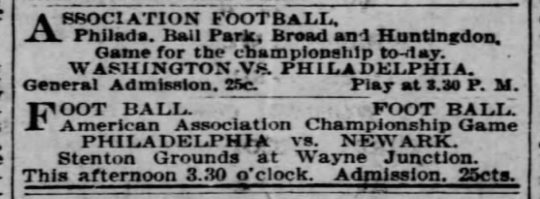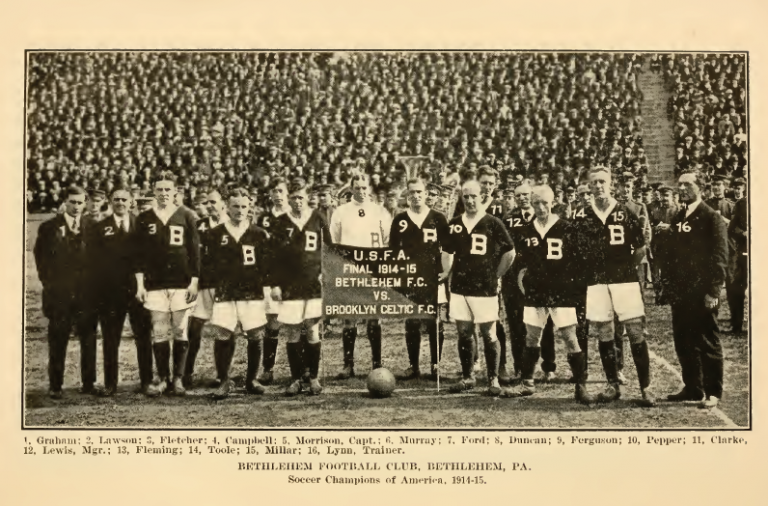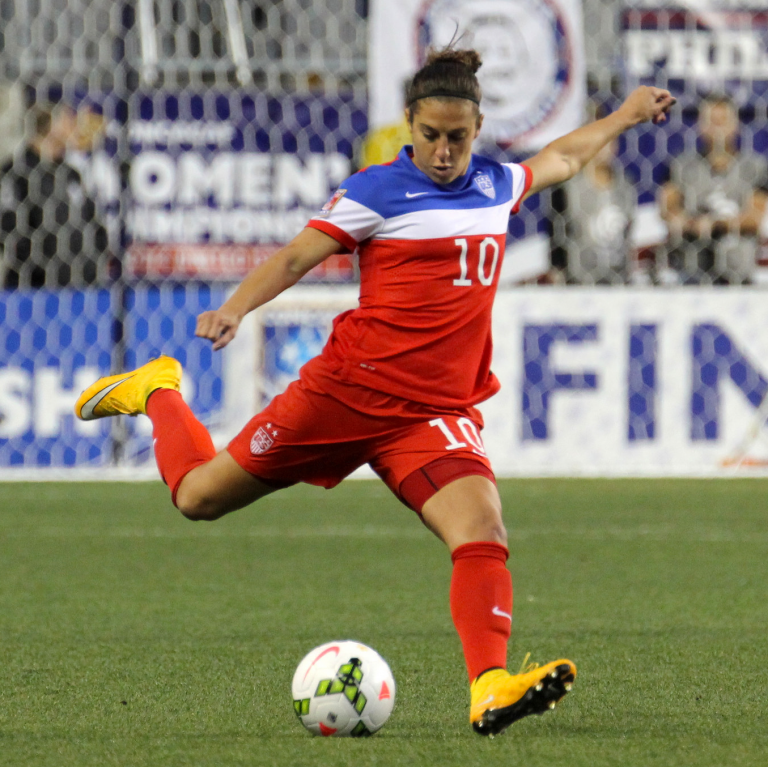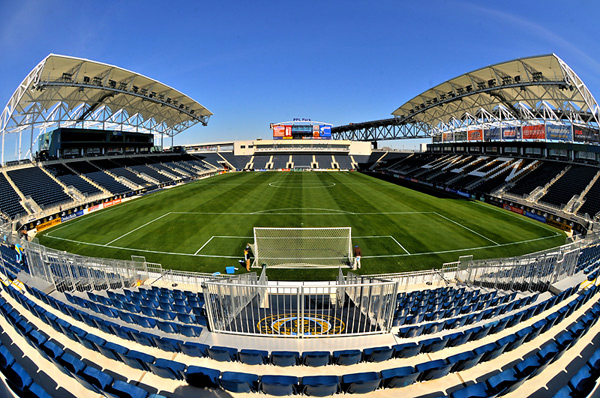Soccer
Essay
Soccer has been played in the Philadelphia area since the late nineteenth century. The rules of Association football, known in the United States as soccer, were formulated in England in 1863. Various forms of football were played in Philadelphia before that time and after, but the first game of soccer in the city “under proper rules” took place on March 19, 1881. Over the next three decades, as the contemporary game became established, amateur leagues were founded at both the youth and senior level, professional league soccer began, and players from the Philadelphia area participated in regional, national, and international games. In the decades that followed, area players, teams, and administrators helped to establish the Philadelphia region as a leading center of the game in the United States.
In its beginnings, soccer in Philadelphia was largely played by British immigrants, many of whom were employed in the city’s textile industry, particularly in the Kensington, Frankford, Port Richmond, and Tacony neighborhoods. Early teams formed in association with ethnic, social, or athletic clubs, some of which were workplace-based. In addition to playing other Philadelphia sides, inexpensive rail transportation allowed Philadelphia teams to also play teams from nearby Eddystone, Pennsylvania; Trenton, New Jersey, and Wilmington, Delaware.
Philadelphia’s first organized league, the Pennsylvania Association Football Union (PAFU), formed in 1889 and included teams from Philadelphia, Chester, and Eddystone. Philadelphia sides were soon traveling as far afield as Trenton, New York, and Pittsburgh for games. Meanwhile, non-league sides organized games of their own. For high-profile intercity games, attendance reportedly exceeded two thousand spectators. Interest in the game was strong enough that most league teams fielded reserve sides of junior players.
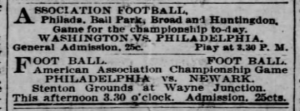
The momentum Philadelphia soccer experienced in the opening years of the 1890s halted during the economic crisis that followed the Panic of 1893, and league soccer did not begin to recover until the end of the decade. Nevertheless, in 1897, the John A. Manz team became the first Philadelphia side to win a major U.S. soccer championship, the American Football Association’s American Cup tournament.
The Fan Base Expands
To this point, soccer in Philadelphia remained a working-class, immigrant sport. Beginning in 1900, however, the city’s leading cricket clubs began to pick up the game, as did some of Philadelphia’s private schools. This interest from native-born social elites helped to further promote the game and was aided by high-profile events such as Philadelphia’s first international “soccer friendly” between the Belmont Cricket Club and members of the touring Bosanquet cricket team of England in 1901. By the end of that year, a new league, the Allied Association Football Clubs of Philadelphia, was flourishing and soon featured senior and junior divisions. In 1904, the Allied Association of Football Clubs backed the formation of the Referees’ Association of Philadelphia, aimed at ensuring uniform standards for referees.
The Philadelphia region also played a prominent role in the birth of college league soccer. Haverford College, which joined the Associated Cricket Clubs of Philadelphia soccer league in 1903, and the University of Pennsylvania were among the founders of the Intercollegiate Association Football League (IAFL) in 1905, during a time of national outcry against the injuries and deaths then occurring in collegiate American football. Soon both schools, along with Lafayette College and Lehigh University, were also competing in the Pennsylvania Intercollegiate Soccer League. Haverford and Penn dominated the early years of collegiate soccer, collectively winning the IAFL championship fourteen times by 1926.
Throughout the first decade of the twentieth century, the growth of league soccer inside and outside the city led to Philadelphia’s emergence as a leading center for soccer in the United States. By 1911, the city had five senior amateur leagues and one professional league that included teams from as far away as Bethlehem and Reading, Pennsylvania, and Trenton and Wilmington. Games featuring Philadelphia teams against touring English amateur sides the Pilgrims (1905, 1909) and the Corinthians (1906, 1911, 1924) further boosted interest in the sport, as did games against leading teams from northern New Jersey, New York, and New England. The first reported game featuring women’s teams took place in 1907, although organized women’s soccer did not become a presence until passage of Title IX of the federal Education Amendments of 1972 spurred expansion of women’s athletics.
Growth of Youth Teams
Soccer’s growth at the senior level gained strength from the organization of competition among school- and club-based youth teams, which in turn facilitated the development of native-born players. In 1908 the Philadelphia School District introduced soccer as an alternative to American football, and the Philadelphia Grammar School Association Foot Ball League began with five teams in Kensington and soon featured teams from North Philadelphia, the Northeast, and West Philadelphia. Soccer competition in Philadelphia’s Catholic League began in 1922 with two schools, Catholic High and St. Joseph’s Prep. At the club level, Lighthouse Boys Club began to emerge as a model for developing youth players, with young players advancing up a ladder of teams as they grew older and more skillful, and the best players advancing to high school, college, and professional teams. Lighthouse later won the national Under-19 championship five times over a thirty-year period and alumni of the club played on the U.S. Men’s National Team at the Olympics and World Cup. Two other area clubs have also won the national U-19 championship, FC Delco and Lehigh Valley United.
National recognition of the impressive growth of local league soccer meant that Philadelphia soccer administrators played a vital role in forming the United States Football Association (later renamed the United States Soccer Federation), in 1913. The Foot Ball Association of Eastern Pennsylvania and District (later known as the Eastern Pennsylvania Soccer Association) was one of the first organizations to affiliate with the new national governing body. When the first officially recognized U.S. national team toured Scandinavia in 1916, five of the fourteen players on the team came from Philadelphia-area clubs. Eight of the seventeen players on the first U.S. Olympic soccer team at the 1924 Games in Paris were also from Philadelphia teams.
Four of those Olympians were from Philadelphia’s Fleisher Yarn team. Backed by the textile manufacturer of the same name, Fleisher Yarn won the inaugural edition of the National Amateur Cup in 1924, a year after the team won the American Cup. Trenton Highlanders, United German Hungarians, and Philadelphia Inter have also won the National Amateur Cup. Area teams have also had success in other senior amateur tournaments, with United German Hungarians and West Chester United champions of the United States Adult Soccer Association’s Werner Fricker Cup.

Changing economic and demographic patterns after World War II furthered soccer’s growth in the region around Philadelphia. Ethnic clubs such as First German Sports Club Phoenix (Phoenixville), United German Americans (Oakford), Vereinigung Erzgebirge (Warminster), and Ukrainian Nationals (Horsham) purchased property in the suburbs, furthering soccer’s development outside of its urban industrial origins in Philadelphia. Former players who had grown up with the game in Philadelphia also founded clubs in the suburbs, which in turn helped to foster the growth of suburban high school soccer. Suburban soccer underwent a further boom in the 1970s, stirred by the popularity of the professional North American Soccer League and the effects of the passage of Title IX. Area teams, for both boys and girls, are now regularly counted among those teams competing for Pennsylvania, New Jersey, and Delaware state high school championships and appear in national rankings of high school teams.
By 2017, the Eastern Pennsylvania Soccer Association included seventeen leagues for men and women. The Eastern Pennsylvania Youth Soccer Association, founded in 1972, included more than 350 member clubs featuring multiple teams for boys and girls across various age and competitive levels. The most competitive clubs participated in the U.S. Youth Soccer Regional League system, and elite clubs participated in the national U.S. Soccer Development Academy program, which identified players for U.S. national teams.
Professional Soccer in Philadelphia
Philadelphia sports administrators and teams participated in founding the first two professional soccer leagues in the U.S. in 1894, the American League of Professional Football Players (ALPF), and the American Association of Professional Football Clubs (AAPF). Both leagues were short lived. Local professional league soccer returned in 1906 with the Pennsylvania League. Largely made up of Philadelphia-based teams, the league also included over its history teams from Camden, Trenton, and Wilmington. In 1909, Pennsylvania League sides Thistle and Hibernian participated in the Eastern League, the first interregional professional league in the U.S. since the ALPF and AAPF.
Philadelphia professional teams began to make their mark on national competition in 1910, when Pennsylvania League champion Tacony won the American Cup championship. The next year, Tacony became the first East Coast team to travel to St. Louis, then the soccer center of the West, helping to lay the groundwork for nationally representative competitions such as the U.S. Open Cup, founded in 1913. Three company-based teams—Bethlehem Steel FC, the Disston Athletic Association team of the Disston Saw Works in Tacony, and Philadelphia Merchant Ship, backed by the Merchant Shipbuilding Corporation with shipyards in Bristol and Chester—participated in the National Association Football League (NAFL), with Bethlehem winning several league championships. Founded in 1907, Bethlehem Steel became the preeminent U.S. soccer team of the era, winning multiple league, American Cup, and U.S. Open Cup championships, and also in 1919 becoming the first U.S. club team to play in Europe, before folding in 1930.
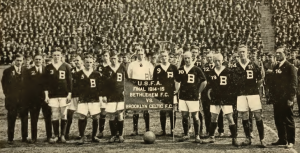
Bethlehem’s success foreshadowed a forty-year period of dominance by Philadelphia professional teams. The Philadelphia German Americans turned pro in 1937 after winning back-to-back National Amateur Cup championships, the 1934-35 championship of a reconstituted semi-professional ASL, and the 1936 U.S. Open Cup. With the U.S. entry into the Second World War, ASL teams “Americanized” their names, which often had ethnic associations, and in 1941 the German Americans rebranded as the Philadelphia Americans, winning the ASL championship five more times under that name. After the franchise was sold in 1953, success continued as the team played as the Uhrik Truckers and won the league championship two more times. During the late 1940s and early 1950s, whenever the Americans/Uhrik Truckers team did not win the ASL championship, another local powerhouse and rival, the Philadelphia Nationals, often did. The Nationals originated in 1936 as Philadelphia Passon, named for backer Harry Passon (1897-1954), owner of Philadelphia’s leading sporting goods company. In 1941 the franchise was sold and the team became team the Philadelphia Nationals, going on to win the ASL championship four times before the team folded in the 1953-54 season. The next local team to dominate the ASL championship, Ukrainian Nationals, won five times between 1960 and 1968 and again in 1970 playing as the Philadelphia Ukrainians. The team also won the U.S. Open Cup four times between the 1960 and 1966. In 1980, Allentown’s Pennsylvania Stoners became the last area team to win the ASL championship before the league folded in 1983.
Financial Erosion Takes a Toll
The relative stability of Philadelphia professional soccer teams during the height of the ASL era declined as the league faced new challenges from new professional leagues. But these new leagues and teams too often lacked sufficient financial backing and fan support for long-term success. Philadelphia Spartans played one season in the National Professional Soccer League at Temple Stadium, finishing second place in the league in 1967. But when the league merged with the United Soccer Association to form the North American Soccer League (NASL), the first fully professional U.S. soccer league since the first ASL, the Spartans did not join the new league. Philadelphia Atoms joined the NASL in 1973 and won the league championship in their inaugural season, leading to goalkeeper and Ridley Park-native Bob Rigby (b. 1951) becoming the first soccer player to appear on the cover of Sports Illustrated, a mark of soccer’s growing place in the wider American sports landscape. Atoms home games were played at Veterans Stadium between 1973 and 1975, with University of Pennsylvania’s Franklin Field home for the team’s final season in 1976. Philadelphia Fury, with Veterans Stadium its home field, debuted in the NASL in 1978 and reached the playoffs twice before moving to Montreal in 1980, leaving Philadelphia without a top-flight men’s professional team for thirty years. The NASL itself collapsed in 1984 as a result of unsustainable rapid expansion and spending. Between 1993 and 2000, several teams from across the region played in lower division semiprofessional outdoor soccer leagues, including Delaware Wizards, Reading Rage, Philadelphia Freedom, Hershey Wildcats, South Jersey Barons, and South Jersey Imperials.
Meanwhile, Philadelphia became home to professional indoor soccer teams. Philadelphia Fever, with the Spectrum as its home, played in the Major Indoor Soccer League (MISL) from 1978 until 1982. Philadelphia KiXX joined the indoor National Professional Soccer League in 1996 and then became a founding member of a relaunched MISL in 2001. Playing home games first at the Spectrum and later at Temple University’s Liacouras Center, the KiXX won two MISL championships before folding in 2010.
The success of the U.S. women’s national team at the 1996 Olympics and 1999 World Cup led in 2001 to the founding of the first fully professional women’s soccer league in the United States, the Women’s United Soccer Association. Philadelphia Charge, a founding team of the league, played its home games at Villanova Stadium before the league folded in 2003. In 2010, Philadelphia Independence joined the Women’s Professional Soccer league, which had been founded the year before, playing home games at West Chester University’s John A. Farrell Stadium in its first season before moving to Widener University’s Leslie Quick Stadium in Chester. The Independence lost the 2011 league championship on penalty kicks before the league folded in 2012 due to financial issues and a dispute between the league’s owners. The following year, the Philadelphia Fever, with its home field at Washington Township High School in New Jersey, played in the WPSL Elite league, which was created as a stopgap before the launch of the National Women’s Soccer League (NWSL) in 2013. As of 2018, Philadelphia was not represented in the NWSL.
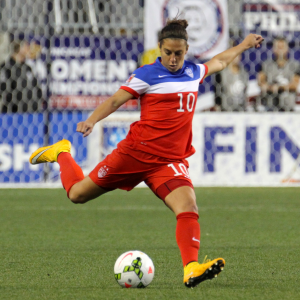
New efforts to establish professional soccer teams in the Philadelphia region followed the decision in 1988 by soccer’s international governing body, FIFA, to award the United States the hosting rights for the 1994 World Cup. The leader of the bid to host the tournament, then-United States Soccer Federation president Werner Fricker (1936-2001), was long associated with the local United German Hungarians team and had played on the U.S. Men’s National Team. The hosting rights required launching a new national first division men’s professional league, and in 1996 Major League Soccer (MLS), the first fully professional men’s outdoor soccer league in the U.S. since the NASL, began play. Unsuccessful efforts to bring a franchise to the Philadelphia area initially focused on New Jersey locations, first Trenton in 2001 and later at Rowan University in Glassboro in 2006.
Stadium Rises in Chester
Unhappy that Philadelphia lacked an MLS franchise, area soccer supporters launched a grassroots campaign to attract the attention of league officials. The Sons of Ben supporters group, founded in 2007 and named after Benjamin Franklin (with a play on the phrase “S.O.B.”), demonstrated that a Philadelphia MLS team would have an existing base of fan support. An 18,500-seat soccer-specific stadium (originally called PPL Park and later Talen Energy Stadium), built with state and local funds as part of a larger redevelopment plan for the Chester waterfront, led to the Philadelphia Union being granted the league’s sixteenth franchise in 2008—the first first-division men’s team in the area since the Philadelphia Fury. Beginning with its inaugural season in 2010, the team had middling success in league play, reaching the MLS playoffs twice while losing the U.S. Open Cup final twice.
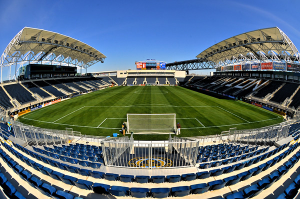
The Union created affiliations with lower division teams aimed at player identification and development, first with Reading United of the Premier Development League in 2009 (other area PDL clubs included Ocean City Nor’easters and Lehigh Valley United), and then in 2010 with Harrisburg City Islanders of the United Soccer League (USL). In 2015, the Union ended its affiliation with Harrisburg City Islanders to launch its own USL team. After a fan vote, the team was named Bethlehem Steel, reviving the name of the champions of the early twentieth century. The team, which made its USL debut in 2016, trains at the Union training facility in Chester but plays home games in Bethlehem at Lehigh University’s Goodman Stadium.
Following the European academy model of player development, in 2013 the Union opened a private high school in Wayne, the YSC Academy. Serving select students playing on the Union’s youth teams (which are part of the U.S. Soccer Development Academy system), the school integrates high school education with high-level training aimed at developing players for professional contracts.
When soccer was first played in Philadelphia in the late 1800s, it was a sport almost exclusively played by British immigrants, but this changed as soccer became established through local leagues and as new immigrant groups and native-born Philadelphians contributed to the sport’s success. Soccer grew to be a familiar part of the American sporting scene, but it retained international reach as the “world’s game.” In the twenty-first century era of cable television and the internet, soccer fans could easily watch and follow favorite teams from around the world. The continuing international flavor of Philadelphia soccer was reflected in the International Unity Cup, a kind of mini World Cup tournament created in 2016 by Philadelphia Mayor Jim Kenney (b. 1958). A program of the City of Philadelphia, led by the Office of Immigrant Affairs and Philadelphia Parks and Recreation, the amateur tournament “unites the city’s neighborhoods and celebrates its diverse immigrant communities through soccer.”
Ed Farnsworth, a member of the Society for American Soccer History, was managing editor of the Philly Soccer Page from 2010 until 2017. A graduate of Temple University (B.A. in American Studies and Political Science) and Drexel University (M.S. in Library and Information Science), his work has appeared at the Philly Soccer Page, Philly.com, TheCup.us, Society for American Soccer History, Centro de Investigaciones de Historia y Estadística del Fútbol Español, EPYSA.org, and in the 2012 MLS All-Star Game program. (Author information current at time of publication.)
Philadelphia-Region Professional League Championship Teams
American Association of Professional Football (1894)
Philadelphia Association (1894)
National Association Football League (1906-21)
Bethlehem Steel FC (1918-19, 1919-20, 1920-21)
American Soccer League (1921-33)
Philadelphia Field Cub (1921-23)
Bethlehem Steel FC (1926-27)
Eastern Professional Soccer League (1928-29)
Bethlehem Steel FC (1928-29, Fall 1929)
American Soccer League (1933-83)
Philadelphia German Americans/Philadelphia Americans (1934-35, 1941-42, 1943-44, 1946-47, 1947-48, 1951-52)
Philadelphia Nationals (1948-49, 1949-50, 1950-51, 1952-53)
Uhrik Truckers (1954-55, 1955-56)
Ukrainian Nationals (1960-61, 1961-62, 1962-63, 1963-64, 1967-68, 1970)
Pennsylvania Stoners (1980)
ASL Lewis Cup (1925-30 / 1940-63)
Bethlehem Steel (1925)
Philadelphia German Americans / Philadelphia Americans (1941, 1943)
Philadelphia Nationals (1949, 1951, 1952)
Uhrik Truckers (1955, 1958)
Ukrainian Nationals (1959)
North American Soccer League (1968-84)
Philadelphia Atoms (1973)
United Soccer League Second Division (1995-2010)
Harrisburg City Islanders (2007)
Major Indoor Soccer League (2001-8)
Philadelphia KiXX (2001-2, 2006-7)
National Premier Soccer League (Amateur, since 2003)
Pennsylvania Stoners (2008)
FC Sonic (2012)
Premier Development League (Amateur, since 1995)
Reading Rage (2009 Regular Season)
Philadelphia-Region National Tournament Championship Teams (Senior)
AFA American Cup (1884-98, 1906-24)
Manz (1897)
Tacony FC (1910)
Bethlehem Steel FC (1914, 1916, 1917, 1918, 1919, 1924)
Fleisher Yarn FC (1923)
Lamar Hunt U.S. Open Cup (1913-present)
Bethlehem Steel FC (1914-15, 1915-16, 1917-18, 1918-19, 1925-26)
Philadelphia German Americans (1936)
Ukrainian Nationals (1960, 1961, 1963, 1966)
National Amateur Cup (1924-present)
Fleisher Yarn (1924)
German Americans (1933, 1934)
Trenton Highlanders (1937)
United German Hungarians (1965)
Philadelphia Inter (1973, 1974)
Werner Fricker Open Cup (1999-2015)
United German Hungarians (1999)
West Chester United (2015)
Philadelphia-Region College Soccer Championship Teams
Intercollegiate Soccer Football League / Intercollegiate Soccer Football Association Championships (1905-58)
Drexel University (1958)
Franklin & Marshall College(1952)
Haverford College (1905, 1906, 1907, 1908, 1911, 1915, 1917, 1926)
Temple University (1951, 1953)
University of Pennsylvania (1914, 1916, 1919, 1920, 1923, 1924, 1930, 1931, 1932, 1933)
West Chester University (1950)
The Soccer Bowl (1950-52)
Temple University (1952)
National Collegiate Athletic Association Division I Men’s Soccer Championships (since 1959)
West Chester University (1961)
National Collegiate Athletic Association Division III Men’s Soccer Championship (since 1974)
The College of New Jersey / Trenton State College (1996)
Elizabethtown College (1989)
Messiah College (2000, 2002, 2004, 2005, 2006, 2008, 2009, 2010, 2012, 2013, 2017)
Rowan University / Glassboro State University (1981, 1990)
National Collegiate Athletic Association Division III Women’s Soccer Championship (since 1986)
The College of New Jersey / Trenton State College (1993, 1994, 2000)
Messiah College (2005, 2008, 2009, 2012, 2013)
Philadelphia Region National Tournament Championship Club Teams (Junior)
James P. McGuire Cup (U-19 Boys: since 1935)
Lighthouse Boys Club (1938, 1948, 1949, 1957, 1967)
Mercerville Juniors (1941)
FC Delco (2000, 2001, 2003)
Lehigh Valley United (2013)
US Youth Soccer Cup (U-18 Boys: since 1994)
FC Delco (2002)
Yardley Makefield Soccer (2011)
Frank Kelly Cup (U-18 Girls: since 1994)
FC Bucks (2009)
FC Penn Strikers (2012)
Don Greer Cup (U-17 Boys: since 1991)
FC Delco (1998)
US Youth Soccer Cup (U-17 Girls: since 1991)
Yardley Makefield Soccer (2016)
Larry Harmon Cup (U-16 Boys: since 1976)
FC Delco (1991)
Mavis Derflinger Cup (U-16 Girls: since 1985)
Willingboro Strikers (1990)
US Youth Soccer Cup (U-15 Boys: since 2001)
FC Delco (2001)
Copyright 2018, Rutgers University
